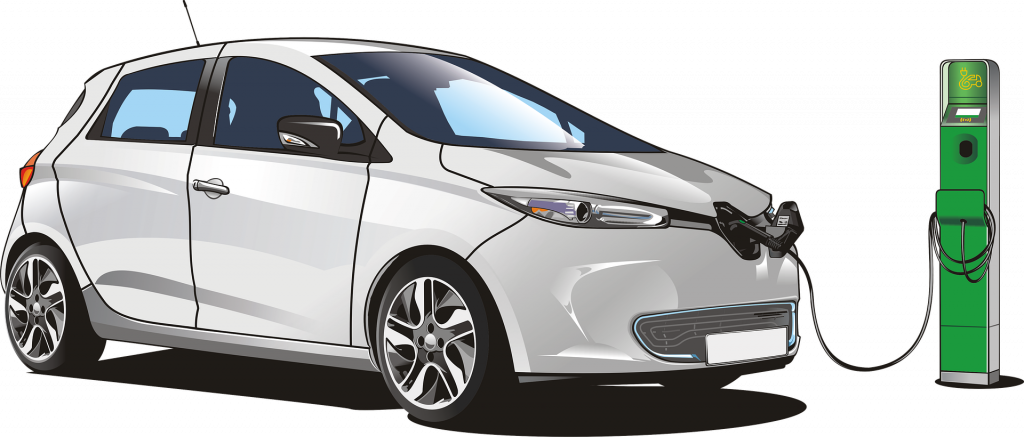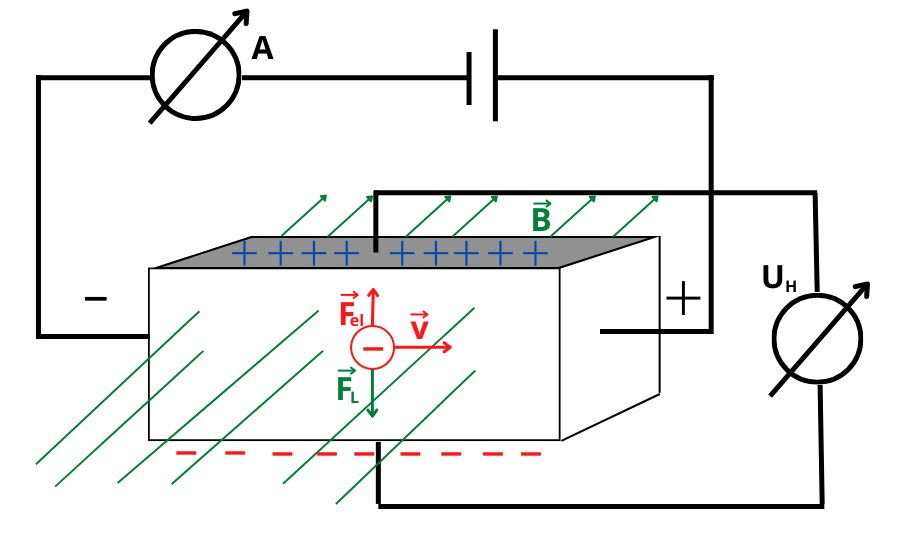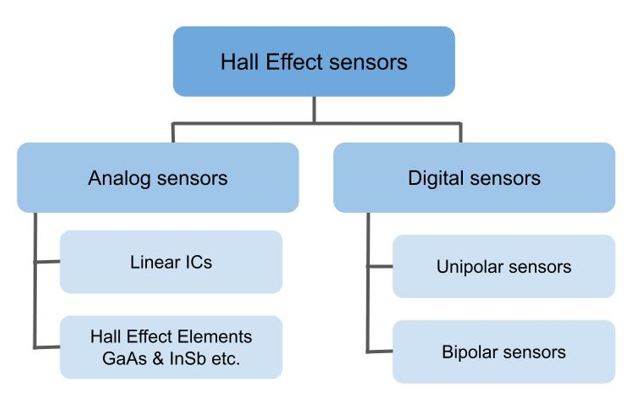Application of Hall Effect Sensors in the Automotive Industry
Yang Liu Comments 3 comments

Hall Effect sensors are commonly used to measure the strength of a magnetic field and the amount of current. Their applications include contactless sensing for linear movements, angular positioning, velocity, and rotational speed and direction, with the advantage of a long-term operation with low wear and tear. With their multiple sensing functions of movement and positioning, Hall Effect sensors in automotive applications can be widely observed in recent years. They have also become the third most common sensor product in vehicles.
A real-life application of the sensors is on buses. In order to ensure the safety of passengers, the driver does not need to be next to the doors to make sure they are securely closed. Instead, Hall Effect sensors can monitor that through the presence of the magnetic field and the changes in voltage levels between the doors and the door frames.

In addition to buses, Hall Effect sensors in automotive applications have also proven their suitability for sustainable mobility, including in hybrid (HEVs) and electric vehicles (EVs). For instance, they assist in the transition from mechanical actuation and timing methods to electrically driven systems in automobiles. With the growing demand for sustainable mobility in recent years, there is an expected market growth of $64 billion for HEVs and EVs by 2026.
In this article, we are going to provide an overview of the application of Hall Effect Sensors in the automotive industry.
What is the Hall Effect?
Named after Edwin Hall (November 7, 1855 – November 20, 1938), the American physicist discovered the Hall Effect in 1879 when he was working on his doctoral thesis. During his experiments, a thin gold leaf (Hall element) was placed on a glass plate, and the gold was tapped off at various points down the thin sheet of conductive material. He discovered that there is a potential difference (Hall voltage) on the opposite sides of the leaf where an electric current was flowing, as a result of a magnetic field perpendicular to the gold leaf.
What is the principle behind a Hall Effect sensor?
When an electric current flows through a semiconductive material, the electrons within will move in a natural straight line. However, if the conductor is exposed to a magnetic field, the Lorentz force, which acts according to the right-hand rule (see fig. 2), causes the electrons movement to change their direction. The Lorentz force causes electrons to move to one side of the conductor, resulting in a potential difference in the conductor called the Hall voltage UH.

The Hall voltage can be described by the following equation:

Ie represents the supply current in the Hall element while B stands for the magnetic flux density, d for the thickness of the sample, and AH for the so-called Hall constant.
The Hall voltage UH is directly proportional to the input current Ie and the magnetic field strength B. Hall Effect sensors use this fact to measure a wide variety of parameters such as current strength, speed, or position.
What are the types of Hall Effect sensors?
There are two main types of Hall Effect sensors, analog and digital.

Analog sensors
In analog sensors, also known as linear Hall sensors, the voltage is directly dependent on the strength of the magnetic field. Thus, the higher the strength of the magnetic field, the higher the output voltage from the sensor.
There are two types of analog sensors: Linear integrated circuits (linear ICs) and Hall Effect Elements.
Linear ICs
Linear ICs consist of a voltage regulator, a semiconductive Hall Element, and a high-gain amplifier. They do not have a Schmidt trigger or a switch for the output transistor, thus the voltage is taken directly from the operational amplifier. The use of a permanent magnet or an electromagnet can generate the output voltage. The output voltage of the sensor is limited by the supply voltage, which can result in saturation voltage when the peak is reached.
Hall Effect Elements
Hall Effect Elements are applicable to produce output voltages through the detection of a magnetic field. The temperature characteristics and the sensitivity of the output voltage depend on the type of semiconductor film material used in the Hall Elements. Elements with gallium arsenide type (GaAs) allow for stable temperature characteristics, while elements with indium antimonide type (InSb) provide hypersensitivity.
They are helpful in measuring distance and rotational movements due to their continuous linear output. Not only, that they can recognize the “on” and “off” states, but they can also produce an analog signal proportional to the strength of the magnetic field. An A/D converter, which can be integrated into the sensor, can translate analog signals into digital ones.
Digital sensors
Digital sensors provide two output states of “on” and “off”. They turn “on” if they detect the presence of a magnetic field (open circuit condition) and will be “off” when there is no detectable magnetic strength (closed circuit condition).
In addition to the voltage regulator, the Hall element, and the high gain amplifier, digital sensors have a Schmitt trigger. The trigger provides hysteresis and reduces the oscillating of output signals as the sensors move around the magnetic field. When the sensors come into contact with a magnet, the external magnetic field as well as the output signal of the digital Hall sensor increases until it reaches the power supply limit.
There are two types of digital sensors, unipolar and bipolar types.
Unipolar digital Hall sensor
The unipolar type of a digital Hall sensor is activated when the magnetic field of one polarity appears. Thus, if a magnet of opposite polarity to the sensor is used, there will be no detection at all by the device. And it only requires a magnetic South pole to operate and release the device.
Bipolar digital Hall sensor
The bipolar type of a digital Hall sensor is activated when a specific pole is created by the electromagnet and is deactivated when the opposite polarity is applied. Contrary to the unipolar type, the bipolar Hall sensors require the magnetic South pole to operate them and the magnetic North to release them.
After learning about the principles of Hall Effect sensors, let’s take a look at some of their common applications in the automotive industry of today!
What are the applications of the Hall Effect sensors in automobiles?
Hall Effect sensors are of great importance in gasoline/diesel-powered, hybrid or electric automobiles. They provide important safety mechanisms, preventing electrostatic discharge against spark ignition hazards, reverse polarity of car batteries, and thermal overload in the motor as well as detecting malfunctions by monitoring overcurrent conditions and triggering protection circuits.
Furthermore, they utilize complex power electronic circuitry to regulate the electric energy flow throughout the vehicle. This is essential in HEVs and EVs, due to the fact that various systems require electrical current sensors to ensure efficient operation, including AC-motor and DC-DC-converter applications. Thus, the application of Hall effect sensors can improve motor performance by providing bandwidth, response time, reduction in noise, and a stable electrical signal in various modes of motor operation.
Hall Effect sensors have also supported the transition from mechanical actuation and timing methods to electrically-driven systems. For example, in traditional internal combustion engines, a fan belt is used to manage the cooling fan, which operates continuously when the engine is running, as well as power-steering pumps and other belt-driven loads. By replacing belt-driven actuators with electric motors, it is possible to achieve better control of the actuators and energy efficiency.
Hall effect sensors provide a wide range of functions. Some common sensors include:
- Parking sensor: They detect obstacles and measure distances between objects and the vehicle during parking, thereby alerting the driver in time.
- Engine speed sensor: They provide car controls with input and measure the engine speed by sensing the coils in crankshafts.
- Wheel speed sensor: These sensors keep track of each wheel’s speed when the vehicle is making turns. The anti-lock braking system makes use of this sensor as well.
- Crankshaft position sensor: They assist in calculating the exact time to input fuel or commence ignition for modern automobile engines to guarantee high speed, high power under low fuel consumption, and low emission.
- Exhaust gas recirculation valve position sensor: The sensors assist in the regulation of exhaust gasses admitted into the cylinders and out of the vehicle.
- Seat belt buckle switch: They help in the determination of a seat’s occupancy.
- Airbag control sensor: These sensors detect the position of the car seat for the correct deployment of airbag protection.
- Windshield wiper fluid level sensor: They measure the fluid reservoir level. That way, a warning light will alert the driver when the level is low.
- Battery management sensor: The sensors monitor current flow/strength during the charging of electric vehicles, as well as battery health as part of the battery management system.
What are the advantages of using Hall Effect sensors in automobiles?
Compared to other sensors like variable reluctance sensors, automotive applications of Hall Effect sensors automotive provide the following advantages:
- They are compact devices, whose installation is easy in different places of the vehicle.
- Due to their contactless sensing functions, Hall effect sensors are subject to low wear and tear. For example, a rotary Hall effect sensor used in the internal combustion engine will not be subject to mechanical wear or changing resistance values.
- They can provide stable operation in an environment of around 150°C and can withstand the high temperature around the engine.
- They have a low risk of burning when installed in the automobile, even when they come into contact with the ignition system breaker.
- They function effectively under various ambient conditions, and are resistant to vibrations, moisture, and dust.
- Compared to traditional sensing solutions, Hall effect sensors have a small footprint and can facilitate high-side and low-side current sensing while reducing the space needed for the printed circuit board.
- Due to the integration of signal processing electronics and the transducer, Hall effect speed sensors have a low susceptibility to electromagnetic interference.
- Compared to variable-reluctance speed sensors, Hall effect speed sensors can better detect non-moving obstacles as well as targets moving at low speed.
What are the limitations of using Hall Effect sensors in automobiles?
As with every technology, there are certain limitations with the application of Hall Effect sensors in automobiles. Some of them are:
- Compared to a conventional electromagnetic sensor, the Hall Effect sensor has a higher cost in general.
- The sensors typically sense a distance of no more than 10 cm unless equipped with a very strong magnet to generate a wide magnetic field.
- Despite a low susceptibility, interference from the engine could nonetheless affect the operation of the sensor and the measurement of current flow.
- High temperature in the exhaust system could influence the resistance of the conductor, and thus the sensitivity of sensors.
Conclusion
With their sensing functions for movement and positioning, Hall effect sensors have proven to be essential components of automobiles. The application of Hall Effect sensors in the automotive industry, particularly in sustainable mobility, has demonstrated their good performance and high reliability even in harsh environmental conditions despite a few limitations.
ChenYang Technologies offers a wide range of different Hall Effect sensors for multiple applications. Based on the requirements, ChenYang Technologies provides customers with the best solution for their applications. Even custom-made products with special requirements can be provided by us.
Visit our company website http://www.chenyang-gmbh.com for more information.
Learn more about the principles of Hall Effect current sensors.
Learn more about Battery Management Sensors and Systems in Electric Vehicles.
Literature:
AG, I. T. (n.d.). Magnetic position sensors. Infineon Technologies. Retrieved August 1, 2022, from https://www.infineon.com/cms/en/product/sensor/magnetic-sensors/magnetic-position-sensors/
AKM. (n.d.). Types and Principles of Hall Elements. AKM. Retrieved August 1, 2022, from https://www.akm.com/eu/en/products/hall-sensor/tutorial/hall-elements/#:~:text=A%20Hall%20element%20is%20an,and%204%20in%20Figure%201a
Allegro MicroSystems. (n.d.). Hall effect current sensing in electric and Hybrid Vehicles. Retrieved August 1, 2022, from https://www.allegromicro.com/en/Insights-and-Innovations/Technical-Documents/Hall-Effect-Sensor-IC-Publications/Hall-Effect-Current-Sensing-In-Electric-And-Hybrid-Vehicles
AZOSENSORS. (2019, September 4). An introduction to hall effect sensors. Retrieved August 1, 2022, from https://www.azosensors.com/article.aspx?ArticleID=16
Emilio, M. D. P. (2020, June 3). Hall device for Critical Automotive Sensing. Power Electronics News. Retrieved August 1, 2022, from https://www.powerelectronicsnews.com/hall-sensor-for-critical-automotive-sensing/
Falchenko, A., Anonym, & Hoa, N. D. (2022, January 19). Hall sensor: Principle of operation, types, application, how to check. AvtoTachki. Retrieved August 1, 2022, from https://avtotachki.com/en/chto-takoe-beskontaktnaya-sistema-zazhiganiya-avtomobilya/
Petruk, O., Szewczyk, R., Ciuk, T., Strupiński, W., Salach, J., Nowicki, M., Pasternak, I., Winiarski, W., & Trzcinka, K. (2014). Sensitivity and offset voltage testing in the hall-effect sensors made of graphene. Recent Advances in Automation, Robotics and Measuring Techniques, 631–640. https://doi.org/10.1007/978-3-319-05353-0_60
Popovic, R. S., Randjelovic, Z., & Manic, D. (2001). Integrated Hall-effect magnetic sensors. Sensors and Actuators A: Physical, 91(1-2), 46–50. https://doi.org/10.1016/S0924-4247(01)00478-2
Power Systems Design. (n.d.). Hall effect current sensing in Hevs and evs. Retrieved August 1, 2022, from https://www.powersystemsdesign.com/articles/hall-effect-current-sensing-in-hevs-and-evs/35/5367
Rutronik Elektronische Bauelemente GmbH. (2021, June 24). Hall sensors in automotive applications – suitable for a variety of parameters. Retrieved July 18, 2022, from https://www.rutronik.com/article/detail/News/hall-sensors-in-automotive-applications-suitable-for-a-variety-of-parameters/
Sensor Solutions Corp. (n.d.). Magnetic sensors for Automotive & Heavy Equipment. Retrieved August 1, 2022, from https://sensorso.com/automotive-heavy-equipment.html
Treutler, C. P. O. (2001). Magnetic sensors for Automotive Applications. Sensors and Actuators A: Physical, 91(1-2), 2–6. https://doi.org/10.1016/s0924-4247(01)00621-
3 thoughts on “Application of Hall Effect Sensors in the Automotive Industry”